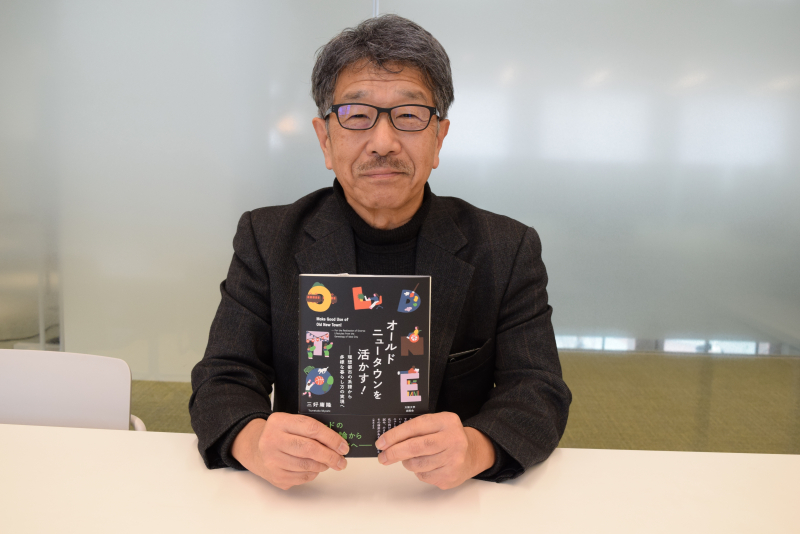生活環境学部長 三好庸隆教授の著書『オールドニュータウンを活かす!』が出版されました。
English below.
ニュータウンの計画・設計に多数携わってきた三好教授が12月、『オールドニュータウンを活かす!―理想都市の系譜から多様な暮らし方の実現へ』(大阪大学出版会)を出版しました。ニュータウンの現状に悩むすべての関係者に、考え方の大きな枠組を提言するとともに、具体的な取り組みの“手引書”にもなっています。
戦後の住宅ニーズにこたえて各地で開発された日本型ニュータウンは、全国で2022地区、総事業面積は大阪府の面積に匹敵する18.9万ヘクタールに上るとも言われ、その多くのニュータウンが少子高齢化によって「オールド化」しています。本書では買い物難民、空き家問題、住宅や施設の老朽化などネガティブな面がクローズアップされがちなニュータウンを再評価。郊外再編とオールドニュータウンの、暮らしの活性化に向けて具体的なビジョンを提言します。関西のニュータウンにスポットを当てている点も特色です。
第Ⅰ部では19世紀、イギリスのハワードが提唱した「ガーデンシティ(田園都市)」に始まる世界の「ニュータウン」の系譜を概観します。日本では、本格的なニュータウンが現れたのは戦後になってから。1962年の千里ニュータウンが第1号とされています。以後、各地で大小のニュータウンが開発されましたが、その多くが少子高齢化とともにオールド化の道をたどっています。
第Ⅱ部では日本のニュータウンにフォーカス。事例として、明石市と神戸市にまたがる明舞団地の取り組みを紹介。兵庫県と兵庫県住宅供給公社が事業主体で1964年に入居を開始した県内最古のニュータウンです。三好教授は2006年度の「明舞団地再生アイディアコンペ」で最優秀賞を受賞して以来、継続的に明舞団地の活性化に取り組んでいます。
オールドニュータウンには「住環境のリフォーム」「在宅医療・介護」「子育て環境の整備」「デジタル時代の郊外住宅地のあり方」など、社会課題解決に向けての潜在的市場があると三好教授は指摘し、再生ではなく「活かす!」発想が必要と訴えます。オールドニュータウンを活かすビジョンとして、「コミュニティ力の強化・まちの魅力強化」「多様な担い手を育てる」「都市圏中心部と新たな補完関係・共創関係を形成する」など5つのビジョンとビジョンごとの取り組むべき事項を32のTO DOリストに纏めて列挙し、最後に現場の声にQ&Aで答えています。
三好教授は「日本版ニュータウンはかつて輝いていた。それをたかだか50年くらいでオールドニュータウンと嘆くのはいかがなものか。日本の地方創生や魅力的郊外形成のために、“活かす!”という発想で取り組むべきで、産官学が総力を集結して、新しいライフスタイル、新しい地方、新しい郊外のあり方を検討し、様々な生活密着型ビジネスの参入を呼び込む仕掛けをすべきだ」と話しています。
In December, Professor Miyoshi, who has been involved in planning and designing many new towns, published "Making the Most of Old New Towns! -From the Genealogy of the Ideal City to the Realization of Diverse Living Styles" (Osaka University Press). The book proposes a broad framework of thinking for all those concerned with the current state of new town, and also serves as a "guide" for specific initiatives.
The number of Japanese-style new towns developed in response to postwar housing needs is said to be 2,022 nationwide, with a total project area of 189,000 hectares, an area equivalent to the size of Osaka Prefecture. This book reevaluates the negative aspects of new towns, which tend to be focused on, such as shopping refugees, problems with vacant houses, and aging housing and facilities. It proposes a concrete vision for the reorganization of suburbs and the revitalization of the old new towns and their lifestyles. Another feature of the book is that it focuses on new towns in the Kansai region.
Professor Miyoshi points out that old new town has a potential market for solving social issues such as renovation of the living environment, home medical care and nursing care, improvement of the child-rearing environment, and how suburban residential areas should be in the digital age, and urges the need to think about the matters.
Professor Miyoshi stated, "The Japanese version of new town used to be a shining example. It is not right to bemoan them as old new towns after only 50 years or so. We should work with the idea of making the best use of it. We should gather the collective efforts of industry, government, and academia to study new lifestyles, new regions, and new suburbs, and create mechanisms to attract a variety of lifestyle-based businesses to the area.”
